|
James Powell and Sons (Whitefriars) Ltd:
Although
James Powell bought the Whitefriars factory in 1834 it was not until about 1860 that the work we now recognise as synonymous
with this company began. It was the work commissioned by William Morris and designed by Phillip Webb, along with the designs
by the architect T.G.Jackson some ten years later, that saw the beginning of a new style by the company, within the Arts &
Crafts genre which broke with the mainstream British traditions of glass design at that time.
Around the same time Harry Powell introduced work that was influenced by Venetian glass,
most notably by the firm of Salviati. He also created wares based on drawings made when visiting museums throughout Europe
and the United Kingdom, which are known as Historistmus glass, or “Glasses with Histories”. Harry Powell produced
the majority of designs used by the firm between about 1875 and the 1920’s, establishing it at the forefront of glass
design and production in Britain. The company
continued to make glass at the same site under the auspices of Harry Powell until the beginning of 1923, when it moved to
the Harrow Weald site where it began a new phase in its development. Harry produced his last design for the company in 1920,
but many of his designs were produced and some even introduced during the 1920’s.
Little is
known about authorship of designs at the firm during the 1920’s until Barnaby Powell produced his first pieces for the
firm in 1929, which followed in the tradition of blown self-coloured vessels that had become synonymous with the firm. Unlike Harry Powell, whose work was light and thin, Barnaby’s designs
gradually became heavier, possibly as a result of working with Capt. Henry Dunn-Cooke who ran the firm of Elferson, which
acted as importers of Wuidart. Powell’s were to produce a range of wares for Wuidart’s under the name of ‘Wealdstone’,
which was initially exclusive to Wuidart and used different colours and shapes to the main production by Powell although some
pieces were adapted from existing patterns. It was also weightier than the normal wares produced by the firm. This was most
likely the influence of Dunn-Cooke, since he produced a number of experimental designs for Powell that are known to be the
thickest and heaviest glass that the firm ever made.
The
influence of the Art Deco style was not immediately obvious in the company’s work, partly because the informal limpid
nature of the glass that they produced did not lend itself directly to the more formal approach of ‘Deco. Yet the work
of two new designers at the company, James Hogan and William Wilson, did manage to encompass the Art Deco ethos, most notably
with the cut glass pieces by Wilson, but also the work by Hogan that referenced Scandinavian style in its approach. Barnaby
Powell also contributed to the stylishly successful Art Deco cut ranges by the firm with a group of shallow bowls on cylindrical
pedestals that he worked on with Albert Tubby, one of the factory’s glasscutters. Some of the work of both Barnaby Powell and James Hogan showed an awareness of Scandinavian
design with its organic simplicity that relied on form and transparent colour, whilst at the same time carrying on in the
tradition largely created by Harry Powell. The ranges designed by Tom Hill, one of the glassblowers in the factory, also exhibited
these qualities. Whilst all the designers produced work on
their own, most also worked in collaboration with one or more of the other designers, or else with factory specialists such
as Tubby. For instance Wilson and Hogan worked together, whilst both Wilson and Barnaby Powell produced their cut designs
with the input of Albert Tubby. Again it was Wilson who combined with Bernard Fitch, the head of the cutting shop, to produce
a range of thick walled, deeply cut pieces.
After the war this “working in tandem” continued when the
firm took on Royal College graduate Geofrey Baxter. Wilson, who was by this time the Managing Director of the company as well
as the main designer, realised Baxter’s potential and employed him as a designer. They worked together on several ranges
notably when Wilson produced the shapes for Baxter’s designs for cut glass in the ‘Contemporary’ style.
Eventually Baxter took over from Wilson as the Chief Designer. Baxter’s innovative work in the 1950’s
and 1960’s with his elegant Scandinavian influenced ranges that were nevertheless quintessentially British; his adaptation
of old lighting moulds to produce the graceful lightweight soda glass vases; and the introduction of the highly successful
brightly coloured textured ranges in soda glass, all took Whitefriars into a new era and indeed enabled it to exist until
its demise in 1980, when the site was sold for re-development.
______________________
Gray-stan During the 1920’s Elizabeth
Graydon-Stannus formerly from Ireland, ran an antique business trading in Antique Irish Glass based in central London in Earl’s
Court Square and had made herself into a recognised authority on the subject. In 1922 she decided to produce reproduction Irish glass and opened a studio , which was marketed under the name of
“Gray-Stan” and made in Battersea, South London.
Production was broadly split into two types.
There was a range
of wares that had a traditional feel and used a palette of clear, dark blue (cobalt), amethyst, amber and turquoise (all transparent
self coloured) and opaque white. The body of a vessel would be in one colour and decorated with another, sometimes two. Often
this was applied as a rim decoration, or as teardrops. Large goblet shaped vases, tall flute vases, other
vase shapes and bowls, sometimes lidded, were also made. Often these pieces were not marked with the engraved script mark
that was usual with much of the company’s production.
A second range of vessels produced by the firm is readily identifiable through its coloured, cloudy opaque style. Items
of this type included vases, bowls, candlesticks, powder-boxes and ginger jars. Both Gray-Stan’s work from these ranges
and Nazeing’s were made in the same way. Firstly, a gather was taken from the kiln, and then it was rolled into sifted
white enamels before melting them into the gather by placing through the glory hole. The marver block was cleaned and the
gather was rolled over the sifted colour enamels. At this stage the swirled effect would be given to the piece by using the
purcellers. Finally, the whole thing would be coated with a layer of glass (the casing), blown and formed
into shape. More usually pieces from these ranges were one colour with white, but two colour items were also produced.
It is sometimes difficult to tell Gray-Stan
and Nazeing apart, but both companies have discernable shapes that are synonymous to each with very few that are common to
both. It is a common fallacy that all Gray-Stan
is marked with an engraved script mark, either “Gray-stan, British” or “Gray-Stan”, however this is
not the case, There may be a number of reasons for this, but the most likely is that work was produced for, and sold by, another
company. In this case it was Elwell & Co.
In 1936 production ceased. There are a number of hearsay stories, some of which appear to have elements of
truth, that throw doubt on the veracity of some of the company’s production. It is believed that pieces were made to
deceive the Old Irish market. Even for the period in which Mrs Graydon-Stannus was trading it would have been difficult to
source as many Old Irish items as she appeared to sell, so one’s natural scepticism is aroused. Perhaps this had some
bearing on the demise of this glassmaking firm.
________________________
Nazeing
Glass Works and its Victorian Origins
The history of Nazeing Glass began in London in the 1870’s with Charles
Kempton who progressed from being a warehouseman to become a supplier and manufacturer of glass, and finally a producer of
glass, along with his two elder sons – quite possibly through the influence of his father-in-law who was a glassblower
for James Powell and Sons (Whitefriars). Charles’s company went through various guises, with a number of partners and
at different addresses in Southwark and Vauxhall before its final move to Nazeing under the auspices of his son Richard.
Much
of the production during the Victorian period was centred round lighting as well as what is now regarded as Victorian “fancy
glass”. Work from this period has often hitherto been attributed to the London firm of James Powell & Sons, and
occasionally to the better quality Stourbridge factories. In particular, a series of Trumpet vases that range from small solifleur
vases through to huge floor standing two-piece items with metal connectors are now known to be by Charles Kempton.
In 1928, what is now the last family owned glass manufacturer in England
moved from Southwark, London due to redevelopment of the area to a site in Hertfordshire. The company, known as Nazeing Glass,
then owned by the Kempton family of glassmakers, bought a property in a low-lying field on the Broxbourne/Nazeing border called
‘The Goats’. There was a large shed, which became the centre for glass production until it was superseded by the
complex of buildings that exist to this day. Indeed, the company logo still incorporates a pair of goats, referring back to
its origins.
It was not until 1930/31 that production began in the “Goat Shed”. Production consisted of a range of
art glass items that included vases, bowls, lighting, desk accessories and paperweights. Most of the wares were what we now
term as “cloudy” and were not unlike the work of Gray-Stan, or some of that produced by Powell in the late 1920’s
and 1930’s. The majority of the pieces produced used a colour, with white enamel underneath giving a pastel effect.
There were also heavily cased pieces that exhibited traits of Italian glass, such as the work of Barovier. During WWII the firm went over to production for the war effort. Malcolm Pollock-Hill
became a shareholder in the 1930’s, eventually purchasing the company in 1942. A tank furnace was installed to assist
in producing work for the Ministry of Aircraft, which enabled other wares to be introduced to the company’s production.
After the war the company started making
drinking glasses and ashtrays for commercial businesses such as hotels and airlines. This culminated in the firm finding work
in niche markets, including pub glass, advertising wares and even a range of Bristol Blue glass retailed through the museum
at Bristol. Malcolm Pollock-Hill’s son, Stephen, became joint managing director in 1990 and only recently retired from
that position, however he still remains active within the company. For a brief period in 1999 the firm experimented with producing Art Glass again and marketed a range of items, but
the project was found to be uncommercial, so ceased.
Much of the current production includes press-moulded glass raging from traffic light lenses to architectural
street lenses (for basements). Only twenty percent of the current output is domestic in nature, being mainly tableware for
hotels and caterers. Nowadays the company has close links with glass artists who can produce more intricate wares that require
different skills to those available in-house.
________________________
Stuart & Sons - Enamel Ware:
In the late1920’s Stuart’s introduced a new range of wares that was
later to account for as much as two thirds of the company’s output. It is possible that it was a response to the pottery
trades move toward the avante garde in the form of Clarice Cliffe and Susie Cooper, both of whom produced designs that epitomised
the Jazz Age.
The people responsible for the new production at Stuart were the chief designer, Ludwig Kny (son of
Frederick Kny the famous engraver, who moved from Czechoslovakia to work in Stourbridge) and Geoffrey Stuart. Kny’s
understanding of the processes involved must have been invaluable to the project. These included applying the decoration,
either freehand or by using an outline black transfer using a copper plate, many of which were engraved by Kny personally.
The outline was then filled in with the appropriate coloured enamels.
The combination of two men who both had a long
family tradition in the world of glass all but ensured the success of the new range, since it combined experience, quality
and an understanding of the spirit of the age. Kny’s routes in Czech glass gave him a unique feeling for decorating
glass vessels in the form of cutting, engraving and enamelling. Whilst Geoffrey Stuart had also grown up within the world
of glass his appreciation was possibly more staid than that of Kny’s since although the company had produced both Art
Nouveau and Arts & Crafts influenced glass, production in the intervening time had been far more provincial and traditional
in its conception.
The enamelled wares echoed the era and included some designs that were highly indicative of the Art
Deco style, whilst others were more fussy using floral motifs more aligned with chintz china ware also being produced at this
time. Vessels used to show off these designs included cocktail shakers and decanters with matching glasses, sundae dish sets,
spill holders and even lighting. Apart from the geometric Art Deco designs and floral motifs, Stuarts produced
items with polka dots, cockerels, butterflies, spiders, bees, fish, birds and even huntsmen.
Enamelled glass ware had haled a fresh era in Stuart’s production and even
found its way into the work designed for the 1934 exhibition “Modern Art for the Table” held at Harrods,
followed by the “Art in Industry” exhibition at the Royal Academy in 1935. Designs by artists such as
Laura Knight who introduced her signature clowns for one design and dancing couples in another certainly endorsed the use
of this medium.
Whilst enamelled ware by Stuart was very popular, it was not meant for a mass market, yet it was priced
competitively, especially when compared to their cut or engraved work, allowing it to find its way into many a home and typifying
both the spirit and taste of the time.
________________________
ROYAL BRIERLEY
(STEVENS & WILLIAMS):
Until
now, apart from the book “The Crystal Years” from 1983, written by R.S. Williams-Thomas (Chairman and fifth generation
family member), no publication has been written solely about this illustrious glasshouse from the Stourbridge area just outside
Birmingham. However, there are sections in a number of books dealing with the earlier period of the factory’s production
and about specific ranges produced by the firm.
During
the late nineteenth century they were well known for the high quality of their work, particularly the cameo wares and overlay
intaglio cut pieces. In addition they were strong experimenters exploring different techniques to achieve decorative forms
and sometimes combining the effects of two or more styles and/or techniques to achieve the required result. A good example
of this would be the highly desirable “Silveria” ware that was produced for a short period around nineteen hundred.
This combined a textured finish with internal silver foil inclusions and additionally used random trailing – usually
green - to finish the effect. (Note: This was also later produced by Frederick Carder in the USA under the name of “Silverina”.)
After the First World War the firm
was awarded the Royal Warrant for its contribution to the war effort. The company went through a difficult time in the 1920’s
and early 1930’s, reflecting the depression of the post war years along with the retirement of its famous designer craftsmen
Joseph Keller and Joshua Hodgetts.
Following
a Royal visit in 1925 Stevens & Williams took the opportunity to change its name to Brierley Royal Crystal and used it
to gain some much needed publicity. Little has been written about their production from the twentieth century, apart from
the work designed for them by Keith Murray as a freelance designer on behalf of the company during the 1930’s when something
over a thousand different designs were produced by him over about a six year period.
The work by Murray falls into several
categories, ranging from the plain green pieces, some having decoration produced using moulds, through to the highly stylised
Modernist clear, cut pieces that are so highly prized by collectors. It is often said that all Murray’s work for Royal
Brierley is marked with an acid etched facsimile script mark that includes the name of Royal Brierley and the firm’s
distinctive fleur-de-lisle logo. This is demonstrably not the case. By far the majority of the pieces that are known to be
by Murray and that have been identified to date are unmarked. The only sure way to identify unmarked pieces at this point
in time is to undertake research in the archives.
At
the same time as producing the stylish wares by Keith Murray the company were producing bread and butter wares. Cut glass
that is often referred to as ‘traditional’ was produced to supply public demand, both in Britain and abroad, and
hence continued to be the conservative, safer, choice of the department store buyers. Yet there are also a large number of
modern designs in the Description Books that are akin to the work of Keith Murray, stylistically and with the occasional use
of the same blanks.
Just as Keith Murray was employed as a consultant by Brierley to produce designs in the 1930’s, so later was
the flower arranger and writer Constance Spry. Unlike Murray’s work, which explored and harnessed the qualities of the
medium, pieces by Spry were necessarily practical because of her background as a flower arranger. Whereas Murray experimented
with shape and technique, Spry ensured that her designs were solid in nature, using traditional forms, such as footed urns,
with, or without handles. To date all the pieces seen have a ripple-moulded finish to the body of the item and most are clear.
Like Murray she achieved the accolade of having a facsimile signature to the base of her designs. She also designed vases
and bowls for Wedgwood, just as Murray did.
Since
so little is known about the production ware produced by the company during the twentieth century it is best not to go off
on the path of conjecture, but sensible to mention some of those known and recognised ranges made by the firm.
Two of the ranges are commonly mistaken for work by James
Powell & Sons from the 1920’s and 1930’s. Powell produced a successful range of thin trailed items and Stevens
and Williams made similar ranges, some with a continuous coloured spiral decorating the entire body of the vessel, another
where the trail broke at regular intervals over the rib of the vessel. There was a further, basically spiral technique, used
by the company for their Rainbow Ware. In it, two colours, in bands, were spiralled up internally through the vessel,
which was often horizontally ribbed. The colours used were usually blue and green, but also pink and green and occasionally
pink and blue combinations were employed. Rainbow Ware continued to be produced for a period after the Second World War.
During the post war years Royal Brierley
continued this production at the same time as employing a trained in-house designer, Deanne Meanley. Work by Meanley echoed
that of Murray, but also included less radical designs to accommodate the buyers, hence stylish items by Meanley are difficult
to find.
Royal Brierley introduced a 'Studio Range' of wares in about 1988, as a reply to the fashion
for coloured blown glass and since there had been a swing away from traditional cut glass. They commissioned Michael
Harris, of Isle of Wight Glass, to advise on the new range, which resulted in items that were consistent with the firm's
production methods. Some were textured, some smooth, but all were treated with fumes of stannous chloride to give an iridised effect.
As with so many of the major British glass
companies Royal Brierley has gone through various guises since it was sold about ten tears ago by the last family member to
run the company, David Williams-Thomas. Now, like many other firms, it does still exist, although primarily as a name owned
by Dartington Glass with which to brand particular ranges.
________________________
LESSER
KNOWN MANUFACTURERS
Bermondsey Glass:
There
is some debate about the dating of this maker, which was based in Southwark, South London. All understanding is based on Cyril
Manley, who suggests a date of 1900 however it is not known what this assumption is based upon. Stylistically the known pieces
show attributes that suggest a later date more likely some time between the World Wars.
Production included both moulded/caste
and blown wares and it is probable that Guy Underwood was the designer since at least one example is marked as by him (three
versions of this piece are known). There are only ten recorded examples of Bermondsey Glass, which can only be identified
if it bears an acid trade mark. Broadfield House Glass Museum now owns three pieces and this writer four. Several of the known
examples bear similarity to the work of Nazeing Glass and, to date, the palette used has been limited to cold tones; also
the use of mica inclusions for decoration.
There is an erroneous claim that if a piece includes mica then it identifies
it as being Bermondsey Glass. It is believed that this stems from an exhibition “Blown in London” held by Circa
Glass at Gray’s Antique Centre which included a fully marked item loaned by Nigel Benson, 20th Century Glass.
________________________
Haden, Mullet
& Haden:
Based
in Amblecote, near Stourbridge, West Midlands and certainly active in the 1930’s most information about this firm is
based upon two pages of illustrations from the Pottery and Glass Trade Gazette in 1930. These give the information that the
firm produced blown art glass and epergnes. Since, to date, no pieces have come to light with labels or trade back stamps,
it is not possible to confirm any characteristics that would help identify this maker's work.
________________________
Hailware:
More is becoming known about
this Leeds based company that made glass under the trade name of ‘Hailware’ and produced miners safety lamps.
The factory was known as the Beacon Works which has given rise to some debate since the firm also made the globes for Belisha
Beacons, the lights used for road crossings in the UK. However, it is unlikely that this was behind the name of the works as
the Belisha Beacon was introduced in 1931, and the works had existed for some time prior to that. Formerly production
was under the company name of Best & Ackroyd, but after 1927 the company was renamed Hailwood & Ackroyd, which in
turn gave rise to the name ‘Hailware’. Other trade names used by the company included ‘Hailcris’,
‘Hailopal’ and ‘Hailglass’.
Apart from miner's lamps and tokens, Hailwood & Ackroyd made globes to go on top of petrol
pumps, including amongst others, Shell, BP, National Benzol and Cleveland as well as parafin globes. All were made
under the trade name of 'Hailware' and can be identified by the black upper case mark on the rim. Other commercial
uses of their globes was for parking and 'In' and 'Out' lamps. A large number of the 'globes' have
an Art Deco style although many would now be thought of as 'traditional'.
To date, very few pieces have been recorded using
the Hailware mark, and only one, a lampshade, using Hailglass. Since there is no proof to date, it is assumed that
Hailwood & Ackroyd went into producing lighting globes as an extension to their production at the time. They produced
both commercial and domestic globes and shades; also widening their production into architectural lighting panels, moulded
glass and blown art glass.
Since there are so few pieces available to study, and no catalogues have
yet come to light, the only way of identifying pieces is if they are marked with the trade name(s). This can be embossed,
painted or incised, depending on the type of ware.
________________________
APPEAL FOR INFORMATION:
It would be of great value to the glass world if any
reader of this who has identifiable pieces by any of the three lesser known manufacturers discussed would contact Nigel. Thank
you.
 |
 |
 |
|
Examples of production from each of the manufacturers discussed
on this page:
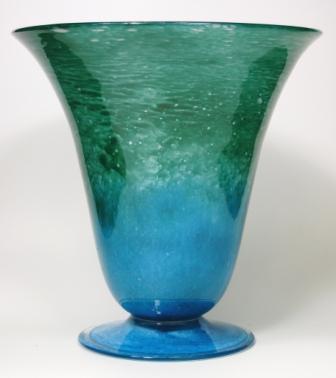
|
| Powell inverted bell vase in two-tone 'Cloudy', c1930 |
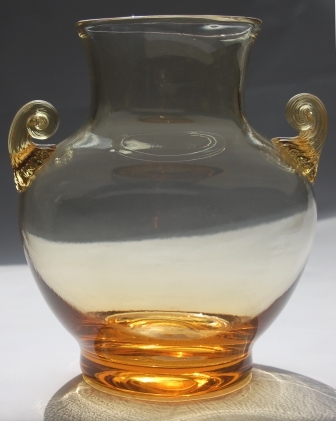
|
| Powell amber vase with scroll handles |
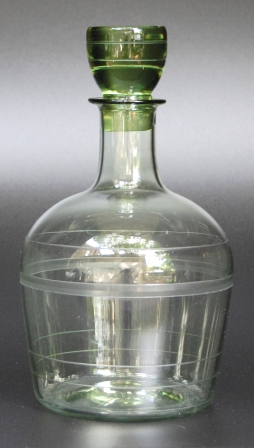
|
| Powell Sea green sherry decanter with unpolished cut bands by Barnaby Powell and WJ Wilson, 1936 |
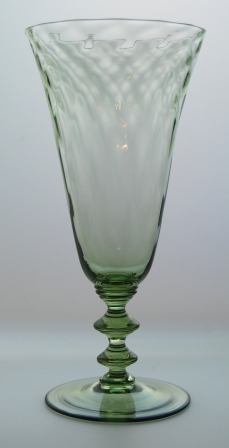
|
| Sea-green diamond moulded vase with two bladed knops to the stem, made by Frank Hill, late 1930's |
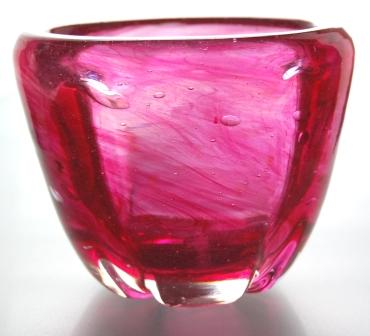
|
| A rare lobed streaky pink bowl des. by Capt HJ Dunne Cook for Powell, signed & dated 1932 |
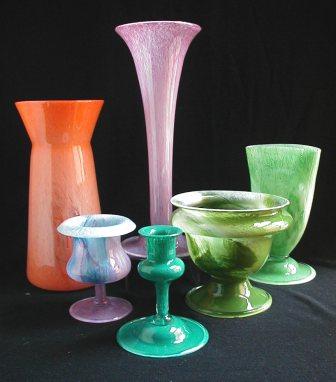
|
| Group of Gray-Stan from 1926-36 |

|
| Two and three colour Gray-Stan glass, made in Battersea, London 1926-36 |
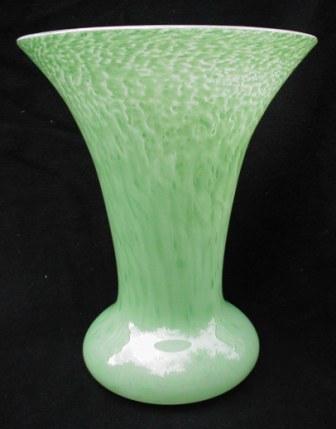
|
| Nazeing 'May Green' Munster Vase, 1930's |
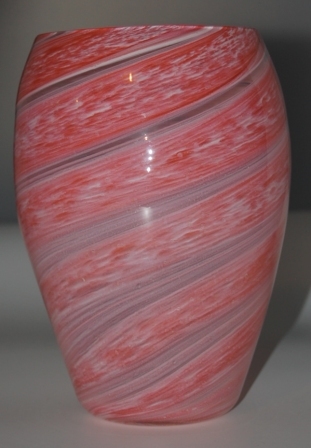
|
| Nazeing 'Barrel Vase' in salmon pink and white cloud 'Swirl' patter, 1930's |

|
| Nazeing may green 'Flint-top' Polo Hat bowl, 1930's |

|
| Nazeing lattice ware heavy ash tray from the 'Ruskin Ware' range, from the post war catalogue pages |

|
| Pre war Mulberry 'Swirl' pattern vase and a post war pink funnel vase |
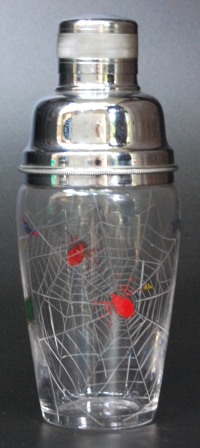
|
| Stuart & Sons 'Spider' cocktail shaker with chrome fittings, 1930's |
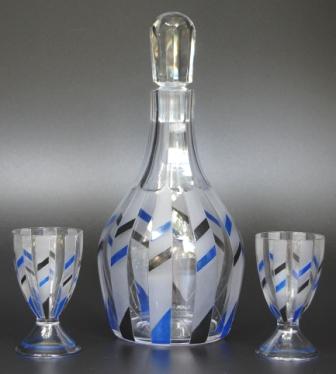
|
| Stuart & Sons decanter and glasses with cut and enamelled chevron enamelled pattern |
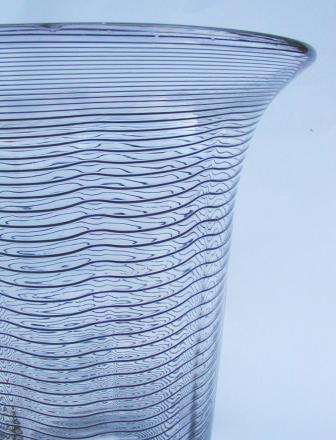
|
| Clear, lightly ribbed Stevens & Williams vase with black trailing |
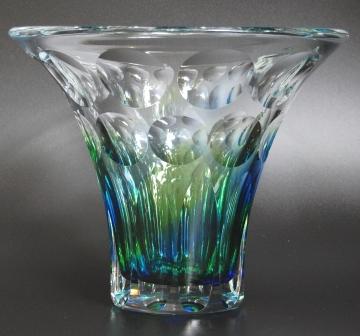
|
| 'Rainbow Ware' flared vase by Stevens & Williams with cut and polished panels |
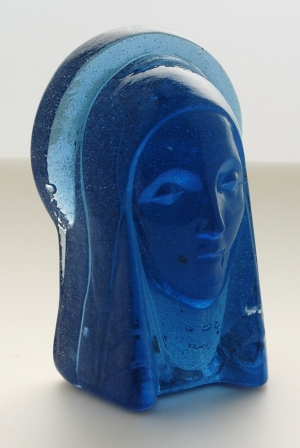
|
| Bermondsey Glass 'Madonna' with full acid mark to the base |

|
| Lighting panel made by Hailwood & Ackroyd, under the trade name of 'Hailware', c1930 |
|
 |
We always hold extensive stock of British pre-war glass, including Powell/Whitefriars, Gray-Stan, Nazeing,
Stuart & Sons enamel wares, Royal Brierley (Stevens & Williams), Thomas Webb and representative items from the,
as yet, more obscure companies. Should you be interested in purchasing anything from these manufacturers or designers, please
email
 |